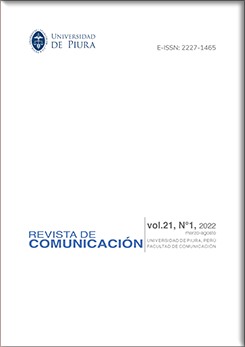El “caballero de frontera” en The Mandalorian (Disney+ 2019-2020)
DOI:
https://doi.org/10.26441/RC21.1-2022-A11Palabras clave:
héroe, space-western, fantasía heroica, The Mandalorian, desplazamiento metafórico, “caballero de frontera”Resumen
En este artículo propongo el concepto de caballero de frontera para definir el prototipo heroico que surge de la conversión de dos géneros narrativos: el space-western y la fantasía épica o heroica. Este concepto se aporta tras la re-visitación del héroe de frontera en la serie The Mandalorian (Disney+, 2019-2020), de acuerdo con algunos rasgos propios del concepto medieval de caballero andante. El arquetipo del héroe de frontera se adscribe al subgénero de space-western, donde recibe su condición de outlaw; sin embargo, gracias a los elementos de fantasía épica que hereda de su pertenencia al universo de Star Wars, el héroe sufre una transformación paulatina en el desenvolvimiento de su misión que lo acerca al caballero andante. Por ello, el objetivo de este artículo es doble: por un lado, categorizar ese arquetipo heroico surgido de la combinación de dos géneros cuyas narrativas presentan semejanzas a través de la figura del outsider como protagonista. Por otro lado, para tal objetivo, se explora una metodología mixta entre la semiótica y la hermenéutica en la cual se aplican los conceptos de desplazamiento metafórico y de relación por semejanza.
Métricas
Citas
Adade-Yeboah, A., Ahenkora, K. & Amankwah, A. S. (2012). The Tragic Hero of the Classical Period. English Language and Literature Studies, 2 (3):10-17. http://doi.org/10.5539/ells.v2n3p10 DOI: https://doi.org/10.5539/ells.v2n3p10
Aristóteles. (1974). Poética. Gredos.
Aristóteles. (1990). Retórica. Centro de Estudios Constitucionales.
Asimov, I. (1999). Sobre la ciencia ficción. Doubleday.
Baracco, A. (2017). Hermeneutics of the Film World. A Ricoeurian Method for Film Interpretation. Palgrave MacMillan. DOI: https://doi.org/10.1007/978-3-319-65400-3
Buscombe, E. (1970). The Idea of Genre in American Cinema. Screen, 33-45. DOI: https://doi.org/10.1093/screen/11.2.33
Campbell, J. (1959). El héroe de las mil caras: psicoanálisis del mito. Fondo de Cultura Económica.
Cascajosa, C. (2005). Prime Time, las mejores series americanas. Calamar.
Chandler, D. (1997). 'An Introduction to Genre Theory' [WWW document] URL http://www.aber.ac.uk/media/Documents/intgenre/chandler_genre_theory.pdf [22/09/2021]
“Disney compra Lucasfilm”, https://elpais.com/cultura/2012/10/30/actualidad/1351627793_778328.html.
Eco, U. (1992) Los límites de la interpretación. Lumen.
Elsaesser, T. & Buckland, W. (2002). Studying Contemporary American Film. A guide to movie analysis. Bloomsbury Academic.
Golden, L. (1994). Aristotle on tragic and comic ‘mimesis’. Scholar Press.
González, J. F. (2007). El héroe del western crepuscular. Dinosaurios de Sam Peckinpah. Fundamentos.
Gordon, A. (1978). Star Wars: A myth of our time. Literature/Film Quarterly, 6(4).
Górna, S. (2019). The Tragedy of Anakin, a Jedi Knight: Star Wars’ Anakin Skywalker as a Shakespearean Tragic Hero. Folio, 5(18): 20-23.
Guerrero, A. P. S. & Jamora, M. J. (2007). The Fall and Redemption of People and Systems: Potential Lessons From the “Star Wars” Saga. Academic Psychiatry, 31: 485-490. https://doi.org/10.1176/appi.ap.31.6.485 DOI: https://doi.org/10.1176/appi.ap.31.6.485
Honegger, T. (2010). (Heroic) Fantasy in the Middle ages-Strange Bedfellows or an Ideal Cast?, Itinéraires, 3: 61-71. https://doi.org/10.4000/itineraires.1817 DOI: https://doi.org/10.4000/itineraires.1817
Starwars.com, (2014, April 25). The legendary Star Wars expanded universe turns a new page. https://www.starwars.com/news/the-legendary-star-wars-expanded-universe-turns-a-new-page
Huerta, M. A. & Sangro, P. (2018). La estética televisiva en las series contemporáneas. Tirant Humanidades.
Huizinga, J. (1985). El otoño de la Edad Media. Alianza Editorial.
Knox, K. (2019). Who are the Mandalorians?, Starwars.com, (2019, November 14). https://www.starwars.com/news/who-are-the-mandalorians
Klapp, O. E. (1949). The Folk Hero. The Journal of American Folklore, 62(243): 17-25. DOI: https://doi.org/10.2307/536852
McDowell, J. C. (2009). ‘Star Wars’ Saving Return. Journal of Religion & Film, 13(1), 6: 1-12.
Mercedes M. (2017). New Paradigms of the Audiovisual Industry. In Mercedes M., Herrero, M. & Urgellés, A. (Eds.). Current and Emerging Issues in the Audiovisual Industry, Wiley (pp. 1-16). DOI: https://doi.org/10.1002/9781119384632.ch1
Muñoz, H. (2016). ¿Son arte las series de televisión? index.comunicación, 6(2): 69-82.
López Gutiérrez, M. L & Nicolás-Gavilán, T. (2016). El análisis de series de televisión: construcción de un modelo interdisciplinario. Revista ComHumanitas, 6(1): 22-39.
Loudikes, P. & Fuller, L. K. (1991). Beyond the Stars: Plot conventions in American Popular films. Bowling Green State University Popular Press.
Patell, C. R. K. (2012). Star Wars and the technophobic imagination". In Brode, D. & Deyneka, L. (Eds.), Myth, Media and Culture in Star Wars: An Anthology, Scarecrow Press (pp.169-183).
Quinn, J. (2020). The past, the present and The Mandalorian. Australasian Journal of Popular Culture, 9 (2): 215-229. https://doi.org/10.1386/ajpc_00028_1 DOI: https://doi.org/10.1386/ajpc_00028_1
Reeves, Ch. H. (1952). The Aristotelian Concept of the Tragic Hero. The American Journal of Philology, 73(2): 172-188. DOI: https://doi.org/10.2307/291812
Ricoeur, P. (1980). La metáfora viva. Ediciones Europa.
Ricoeur, P. (1999). Historia y narratividad. Paidós.
Schütrumpf, E. (1989). Traditional Elements in the Concept of Hamartia in Aristotle's Poetics. Harvard Studies in Classical Philology, 32:137-156. DOI: https://doi.org/10.2307/311356
Seal, G. (2009). The Robin Hood Principle: History, Myth and the Social Bandit. Journal of Folklore Research, 46(1): 67-89. DOI: https://doi.org/10.2979/JFR.2009.46.1.67
Stinton, T. C. W. (1975). Hamartia in Aristotle and Greek Tragedy. The Classical Quarterly, 25(2): 221-254. DOI: https://doi.org/10.1017/S0009838800030068
Taylor, C. (2015). How Star Wars conquered the Universe: the Past, Present and Future of a multibillion dollar franchise. Basic Books.
Umland, R. A. (2016). The Typology of True Knight: Sir Thomas Malory’s Lancelot. In Outlaw Heroes as Liminal Figures of Film and Television, McFarland and Co., North (pp. 11-21).
Vallejo Campos, A. P. (2004). El concepto aristotélico de phrónesis y la hermenéutica de Gadamer. En Zúñiga García, J. F., Sáez Rueda, L., Pérez Tapias, J. A., Nicolás Marín, J. A. y Acero Fernández, J. J. (Coord.). El legado de Gadamer (pp. 465-486). Editorial Universidad de Granada.
Vogler, C. (2002). El viaje del escritor. Las estructuras míticas para escritores, guionistas, dramaturgos y novelistas. Robinbook Manontroppo.
Williams, D. (2013). The Tragedy of Power in the Godfather and Star Wars. In DiPaolo, M. (ed.), Unruly Catholics from Dante to Madonna: Faith, Heresy, and Politics in Cultural Studies (pp. 125-149).
Filmografía
Ford, J. (Director). (1948). 3 Godfathers. [Película]. Estados Unidos: Argosy Pictures, Metro-Godlwyn-Mayer.
Lucas, G. (Director). (1977). Star Wars. [Película]. Estados Unidos: Lucasfilm.
Kimber, S, Filoni, D. & Beck, C. (Creadores). (2014). Star Wars Rebels. [Serie]. Estados Unidos: Lucasfilm, Lucasfilm Animation.
Favreau, J. (Director). (2019). The Mandalorian. [Serie]. Estados Unidos: Lucasfilm, Fairview Entertainment, Golem creations.
Publicado
Cómo citar
Número
Sección
Licencia
Derechos de autor 2022 Revista de Comunicación

Esta obra está bajo una licencia internacional Creative Commons Atribución-NoComercial-SinDerivadas 4.0.











 Portal de Revistas de la Universidad de Piura.
Portal de Revistas de la Universidad de Piura.